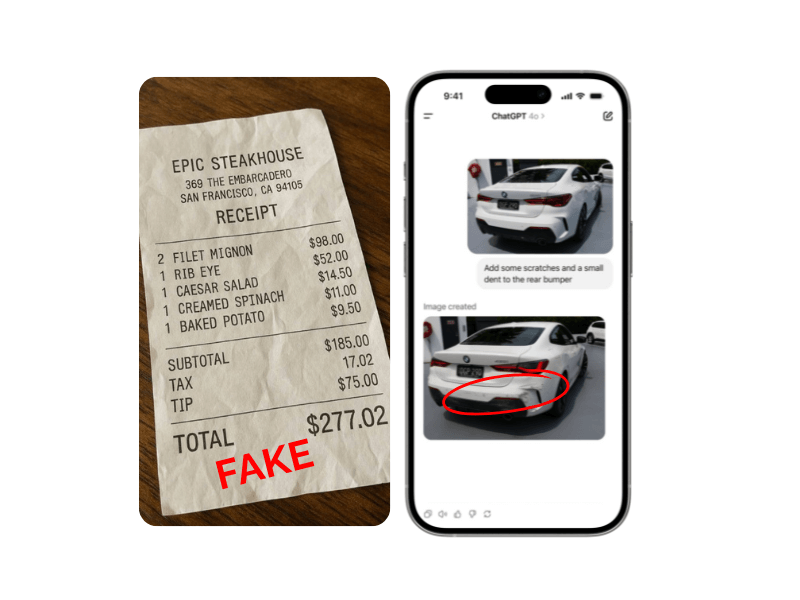We can no longer trust what we see
“Seeing is believing” is now an outdated — and potentially dangerous — statement.
Today, no one can any longer afford to take for granted the authenticity and truthfulness of what they see.
In fact, generative technology allows for the full manipulation of reality and in an extremely credible manner, enabling the dissemination of entirely fake digital content across any context.
An example? Here are two striking contents circulating online:
- A $300 restaurant receipt from an alleged restaurant but completely generated by AI — complete with logo, address, list of dishes, and time.
- A real photo of a car sent to GPT chat, which on request added scratches and a dent, thus making it fake.

The authenticity of these contents was entirely erased by artificial intelligence, with just a few typed prompts.
What’s alarming is that these photos could be used as legal evidence, claims, defamatory posts or to support false statements.
Unfortunately, this is no longer a futuristic scenario — it’s already happening. And it demands an urgent reflection on the integrity of digital data, the reliability of information, and the growing need for tools that can verify the authenticity of evidence.
Deepfake Intelligence: an invisible but real threat
“Deepfake intelligence” refers to the ability of generative AI to construct or alter information by combining real and synthetic elements in a highly realistic way.
In this way, even to the most experienced eyes, the final content appears making artificiality nearly impossible to detect without dedicated tools.
That’s because AI’s computational power has now gone beyond simple visual edits.
We’re in the realm of trust manipulation — and that’s what we need protection from.
Major and current examples of deepfakes include:
- Altered photos, audio and videos
- Falsified emails
- Screenshots with altered metadata
- Apparently valid documents, but entirely artificially created
The consequences? An exponential increase in:
-
Insurance and legal fraud
Increasingly frequent disputes - False evidence in court proceedings
- Rampant disinformation
Now more than ever, we can no longer wait. We need a new culture of digital truth, capable of dealing with a systemic and transversal threat, affecting citizens, companies and institutions.
Why deepfake detection is not enough (and never will be)
Deepfake detection software has significant limitations that reduce its practical effectiveness by failing to keep up with the evolution of AI. However advanced, they have technical, operational, regulatory and social limitations.
Here are the main critical points:
- Technical limitations of detection AIs: neural networks used to identify fake content are often trained on overly specific datasets, making them unreliable when exposed to new, unfamiliar, or culturally diverse data. Furthermore, many models detect visual and semantic patterns, but are not able to identify unique fingerprints.
- Underperformance in real-world scenarios: current technologies work well on public figures or controlled content, but show a drastic drop in accuracy with ordinary citizens or real scenarios. Even a 2-3% error can alter electoral, legal or financial outcomes.
- Social and ethical implications: mass surveillance can compromise privacy. False positives or negatives undermine trust in institutions, media and democratic processes. Human errors in the interpretation of results also generate risks of censorship, exclusion or defamation.
What begins as a technical challenge evolves into a cultural, societal, and legal issue. It calls for a stronger strategy: certify what is authentic — before it is contested.
TrueScreen: prevention against deepfakes
In a world where digital manipulation is becoming increasingly sophisticated, the only effective solution is prevention and verification of authenticity.
TrueScreen was created with precisely this mission: to certify upstream the origin and authenticity of any content, ensuring it is legally recognized, tamper-proof, and protected against reputational or legal attacks.
Thanks to its patented forensic technology, TrueScreen allows users to:
- Capture digital content (photos, videos, audio, screenshots, documents) directly from the source and in real time
- Digitally seal and timestamp files through recognised certification authorities
- Generate forensic technical reports, complete with cryptographic hashes, metadata, timestamps and geolocation, and usable in judicial and investigative contexts
- Sign contents with advanced electronic signature (AES) compliant with eIDAS and AGID
- Easily integrate services into apps, CRMs, enterprise portals and legacy systems using APIs and SDKs
These features make TrueScreen a unique solution for preventing fraud, disputes and disinformation for businesses, professionals and public institutions.
In a world where everything can be created, truth must be certified
If today it is increasingly complex to distinguish the true from the false, it is necessary to guarantee the true from the start.
With TrueScreen, certifying the authenticity of any content has never been easier.
Every piece of evidence is indisputable – and truth has legal value.
In recent years, considerable progress has been made in the field of generative artificial intelligence, which has revolutionised the way digital content is created and shared. Although there are legitimate applications, these technologies expose everyone to increasing risks of manipulation and forgery.
The two examples we mentioned – the receipt and the car – are only part of a phenomenon that already exists and is destined to multiply.
In the aftermath, those same contents may be used as evidence in court, claims or tools of defamation. That is why, today, appearances are more deceptive than ever, and the authenticity, integrity and origin of any content must be guaranteed — in a certain and verifiable manner.
With TrueScreen, certifying digital truth is easy, fast and legally compliant. Every piece of data acquired has evidentiary value, every document is immutable, every piece of evidence is incontestable.
And trust is not assumed: it is certified.
